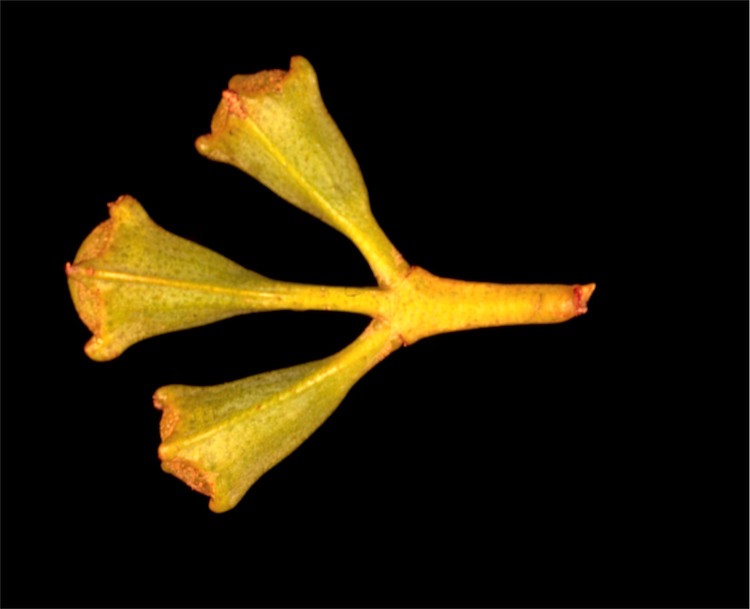|
Eucalyptus Gittinsii
''Eucalyptus gittinsii'', commonly known as northern sandplain mallee, is a species of mallee that is endemic to Western Australia. It has smooth greyish bark, sometimes with rough flaky bark near the base, lance-shaped to curved adult leaves, flower buds in groups of three, whitish flowers and cylindrical to barrel-shaped fruit. Description ''Eucalyptus gittinsii'' is a mallee that typically grows to a height of and forms a lignotuber. It has smooth brownish to white bark, sometimes with rough, flaky bark that peels off near the base of the trunk. Young plants and coppice regrowth have leaves arranged in opposite pairs, broadly lance-shaped, long and wide. Adult leaves are arranged alternately, lance-shaped to curved, long and wide on a petiole long long. The flower buds are arranged in leaf axils in groups of three on a peduncle long, the individual buds on pedicels long. Mature buds are club-shaped, long and wide with a rounded to flattened operculum. Flowering oc ... [...More Info...] [...Related Items...] OR: [Wikipedia] [Google] [Baidu] |
Murchison River (Western Australia)
The Murchison River is the second longest river in Western Australia. It flows for about from the southern edge of the Robinson Ranges to the Indian Ocean at Kalbarri. The Murchison-Yalgar-Hope river system is the longest river system in Western Australia. It has a mean annual flow of 208 gigalitres, although in 2006, the peak year on record since 1967, flow was 1,806gigalitres. Basin The Murchison River basin covers an area of about in the Mid West region of Western Australia. It extends about inland from the Indian Ocean, onto the Yilgarn Craton east of Meekatharra and north of Sandstone. Rain generally falls in the upper basin during summer cyclones, so for much of the year the Murchison River does not flow, leaving a dry sandy river bed and intermittent permanent pools. The eastern reaches of the basin contain large chains of salt lakes, which flow only following rainfall. The drainage lines from these lakes merge to form the Murchison River about north-northea ... [...More Info...] [...Related Items...] OR: [Wikipedia] [Google] [Baidu] |
National Herbarium Of New South Wales
The National Herbarium of New South Wales was established in 1853. The Herbarium has a collection of more than 1.4 million plant specimens, making it the second largest collection of pressed, dried plant specimens in Australia,Thiers, B. (2020 – continuously updated). National Herbarium of New South Wales Collections Summary. ''Index Herbariorum. A global directory of public herbaria and associated staff. New York Botanical Garden's Virtual Herbarium.'' Available fromNSW Collections Summary(accessed 21 August 2020) including scientific and historically significant collections and samples of Australian flora gathered by Joseph Banks and Daniel Solander during the voyage of in 1770. The Herbarium is a centre for Australian plant research. These specimens are used for studies of Australian native plants, their relationships and classification. A botanical information service is also provided including native plant identifications. The National Herbarium is in the Robert B ... [...More Info...] [...Related Items...] OR: [Wikipedia] [Google] [Baidu] |
Myrtales Of Australia
The Myrtales are an order of flowering plants placed as a sister to the eurosids II clade as of the publishing of the ''Eucalyptus grandis'' genome in June 2014. The APG III system of classification for angiosperms still places it within the eurosids. This finding is corroborated by the placement of the Myrtales in the Malvid clade by the One Thousand Plant Transcriptomes Initiative. The following families are included as of APGIII: * Alzateaceae S. A. Graham * Combretaceae R. Br. ( leadwood family) * Crypteroniaceae A. DC. * Lythraceae J. St.-Hil. ( loosestrife and pomegranate family) * Melastomataceae Juss. (including Memecylaceae DC.) * Myrtaceae Juss. (myrtle family; including Heteropyxidaceae Engl. & Gilg, Psiloxylaceae Croizat) * Onagraceae Juss. (evening primrose and Fuchsia family) * Penaeaceae Sweet ex Guill. (including Oliniaceae Arn., Rhynchocalycaceae L. A. S. Johnson & B. G. Briggs) * Vochysiaceae A. St.-Hil. The Cronquist system gives essentially the same co ... [...More Info...] [...Related Items...] OR: [Wikipedia] [Google] [Baidu] |
Eucalyptus
''Eucalyptus'' () is a genus of over seven hundred species of flowering trees, shrubs or mallees in the myrtle family, Myrtaceae. Along with several other genera in the tribe Eucalypteae, including '' Corymbia'', they are commonly known as eucalypts. Plants in the genus ''Eucalyptus'' have bark that is either smooth, fibrous, hard or stringy, leaves with oil glands, and sepals and petals that are fused to form a "cap" or operculum over the stamens. The fruit is a woody capsule commonly referred to as a "gumnut". Most species of ''Eucalyptus'' are native to Australia, and every state and territory has representative species. About three-quarters of Australian forests are eucalypt forests. Wildfire is a feature of the Australian landscape and many eucalypt species are adapted to fire, and resprout after fire or have seeds which survive fire. A few species are native to islands north of Australia and a smaller number are only found outside the continent. Eucalypts have been grow ... [...More Info...] [...Related Items...] OR: [Wikipedia] [Google] [Baidu] |


